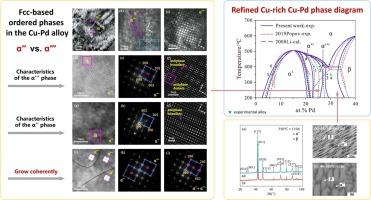面心立方Cu-Pd合金的有序-无序相变和相平衡
IF 6.3
2区 材料科学
Q2 CHEMISTRY, PHYSICAL
引用次数: 0
摘要
铜钯合金熔点高,是潜在的高温钎焊填料。为了给钎焊填料的开发提供热力学指导,本文通过常规x射线衍射(XRD)、电子探针微分析(EPMA)、高分辨率转变电子显微镜(HRTEM)和选择区域电子衍射(SAED)对面心立方Cu-Pd合金有序-无序相变和相平衡进行了实验研究。结果表明,Cu-Pd合金在400°С和350°С处存在4种不同的面心立方(fcc)结构,由无序相α和有序相α´、α ‘和α ’组成。α′′相是二维长周期超结构(2D-LPS),具有平行于(100)fcc平面的非保守反相边界和SAED中的双层超晶格反射模式。α ‘ ’相的晶格常数与已建立的α ‘ ’相(1D-LPS)相似,它们的相干生长使它们难以用传统的XRD分析进行区分。目前观测到的α′+ α′、α′+ α′和α′+ β两相区域与以往报道的数据有明显的偏差。基于这些发现,对Cu-Pd相图的富cu侧进行了相应的细化。本文章由计算机程序翻译,如有差异,请以英文原文为准。

Ordered-disordered phase transitions and phase equilibria in face-centered cubic Cu-Pd alloys
Cu-Pd alloys are potential high-temperature brazing fillers due to their high melting points. To offer thermodynamic guidance for the development of brazing fillers, the present work experimentally investigated the ordered-disordered phase transitions and phase equilibria of face-centered cubic Cu-Pd alloys through conventional X-ray diffraction (XRD), electron probe microanalysis (EPMA), high-resolution transition electron microscopy (HRTEM) and selected area electron diffraction (SAED). The results reveal the presence of four distinct face-centered cubic (fcc) structures in the Cu-Pd alloys at 400 °С and 350 °С, consisting of the disordered α phase and three ordered phases: α´, α′′ and α′′′. The α′′′ phase is confirmed to be a two-dimensional long-period superstructure (2D-LPS), uniquely characterized by the non-conservative antiphase boundary parallel to the (100)fcc plane and the double-layer superlattice reflection patterns in SAED. The lattice constants of the α′′′ phase are analogues to those of the well-established α′′ phase (1D-LPS), and their coherent growth makes them difficult to distinguish using conventional XRD analysis. The presently observed two-phase regions of α′ + α′′, α′′ + α′′′ and α′′′ + β deviate obviously from the previous reported data. Based on these findings, the Cu-rich side of the Cu-Pd phase diagram is refined accordingly.
求助全文
通过发布文献求助,成功后即可免费获取论文全文。
去求助
来源期刊

Journal of Alloys and Compounds
工程技术-材料科学:综合
CiteScore
11.10
自引率
14.50%
发文量
5146
审稿时长
67 days
期刊介绍:
The Journal of Alloys and Compounds is intended to serve as an international medium for the publication of work on solid materials comprising compounds as well as alloys. Its great strength lies in the diversity of discipline which it encompasses, drawing together results from materials science, solid-state chemistry and physics.
 求助内容:
求助内容: 应助结果提醒方式:
应助结果提醒方式:


